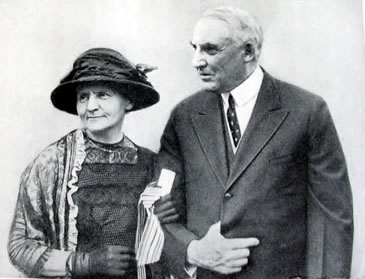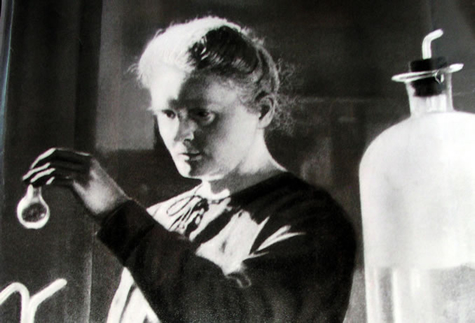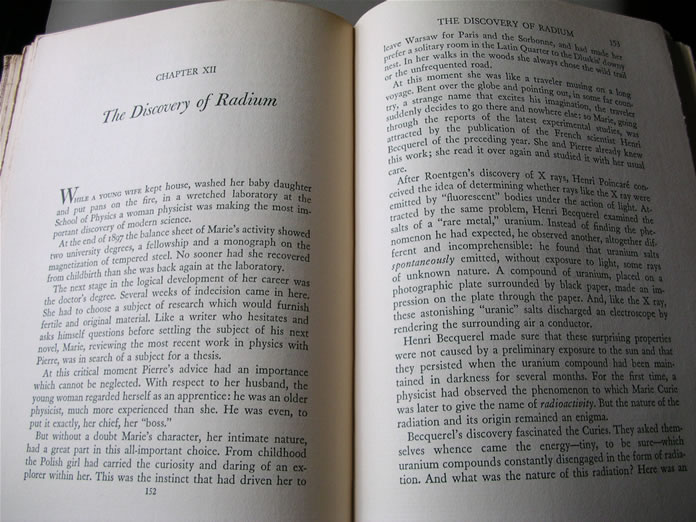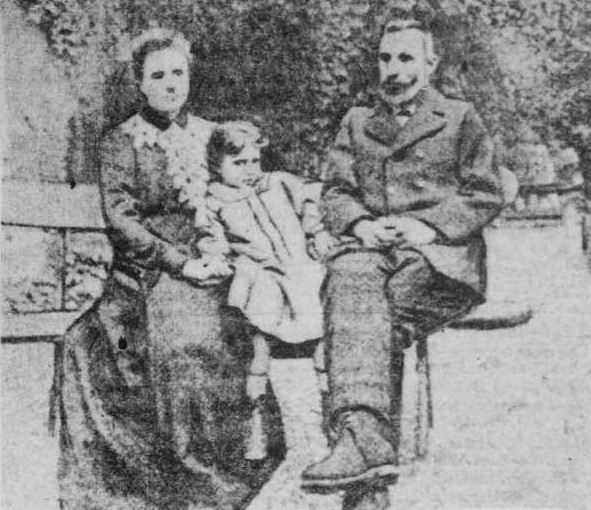Madame Curie: A Biography, by Eve Curie
Author: M. Crasnier-Mednansky, Ph.D., D.Sc.Copyright © 2006 Mednansky Institute, Inc.
Marie Curie’s life best illustrates that the way of progress is
neither swift nor easy, and entails a sense of intellectual liberty and independence. With the biography by her daughter Eve Curie, the reader is brought closer to
'Madame Curie' the woman who, in collaboration with her husband Pierre Curie, discovered
and studied a new chemical element she called radium whose radiation was far
more intense than that of any other known element at that time. In her
1911 Nobel lecture she humbly mentioned: "All the elements emitting such
radiation I have termed radioactive, and the new property of matter revealed
in this emission has thus received the name radioactivity".
With the biography by her daughter Eve Curie, the reader is brought closer to
'Madame Curie' the woman who, in collaboration with her husband Pierre Curie, discovered
and studied a new chemical element she called radium whose radiation was far
more intense than that of any other known element at that time. In her
1911 Nobel lecture she humbly mentioned: "All the elements emitting such
radiation I have termed radioactive, and the new property of matter revealed
in this emission has thus received the name radioactivity".
Marie Curie struggled with many aspects of life. She suffered from loneliness, financial hardship, difficult work conditions, and notoriety which she said "makes life more difficult". She was remarkable for having a strong sense of duty towards humanity and no other ambition than to be able to work for science freely.
From a ton of pitchblende residues Pierre and Marie Curie isolated radium as a pure element in a "miserable old shed" where for years (from 1898 to 1902) they were too cold in winter, too hot in summer and submitted to irritating gases due to a poorly equipped facility. She later mentioned that one year would have probably been enough for the same purpose if reasonable means had been at their disposal. However, in her autobiographical notes she mentioned: "But I shall never be able to express the joy of the untroubled quietness of this atmosphere of research and the excitement of actual progress with the confident hope of still better results".
At Pierre Curie’s death in 1906 she faced increasing difficulties but was able to manage the care and education of two young daughters (Irène was 9 and Eve not quite 2 years old when Pierre died) while keeping her scientific research uninterrupted until her death in 1934.
During World War I she established several hundreds of radiology stations to facilitate the examination of the wounded and tirelessly trained assistants in using X-ray machines. The end of the war brought her great joy with the "deserved resurrection" of Poland, her native country, after a century of oppression. Her most ardent desire, the creation of a radium institute in Warsaw, was fulfilled in 1932 with the inauguration of the 'Marie Curie-Sklodowska Radium Institute'.
In 1921, upon the generous initiative of Mrs. W. B. Meloney (also known as Marie Mattingly Meloney) the women of America collected a fund, 'the Marie Curie Radium Fund', for the gift of a gram of radium for Marie to continue her research (a gram of radium was worth about $70,000 at the time due to production cost). She was invited to America to receive the radium from President Harding (he offered Marie Curie the golden key opening the casket containing the radium) and during her visit conquered the heart of millions of Americans. She went back to France "with a feeling of gratitude for the precious gift of the American women, and with a feeling of affection for their great country tied with ours by a mutual sympathy which gives confidence in a peaceful future for humanity". She returned to America a second time in 1929 to receive a second gram of radium, this time to help build the Radium Institute in Warsaw.

Marie Curie and President Harding at the White House, May 20, 1921
Pierre and Marie Curie voluntarily did not patent the process they used to prepare radium. Their friends justly argued that, would they have guaranteed their rights, they could have secured the financial means for their research without facing the constant difficulties which were a handicap to both of them during their lifetime. However she wrote: "Humanity … needs dreamers, for whom the unselfish following of a purpose is so imperative that it becomes impossible for them to devote much attention to their own material benefit".

Marie Sklodowska Curie in her laboratory at the University of Paris, 1925
Madame Pierre Curie, Professor at La Sorbonne, Nobel Prize in Physics and Nobel Prize in Chemistry died at Sancellemoz, Haute-Savoie, France at the age of 67. The hands that had accomplished so much work were callous and deeply burnt by radium. She was among those who believe that "science has great beauty" and "a scientist in his laboratory is not only a technician: he is also a child placed before natural phenomena which impress him like a fairy tale".
In the cemetery at Sceaux where she was buried, a new epitaph was added to the family tomb 'Marie Curie-Sklodowska, 1867-1934'. In 1995 Pierre and Marie Curie's remains were laid to rest under the dome of the Pantheon in Paris where many of France’s national heroes are buried, with great pomp and ceremony. This was quite unfortunate, as it was disrespectful of their mind and spiritual legacy.

"At this moment she was like a traveler musing on a long voyage. …the traveler suddenly decides to go there and nowhere else; so, Marie… was attracted by the publication of the French scientist Henri Becquerel of the preceding year" Quotation is from Madame Curie by Eve Curie in Chapter XII: The Discovery of Radium.
Miscellanea:
Nobel Lecture delivered by Marie Curie on December 11, 1911 after she was awarded the 1911 Nobel Prize in chemistry. In 1903 the Nobel Prize in physics was awarded to Antoine Henri Becquerel for his discovery of spontaneous radioactivity, and Pierre and Marie Curie for their joint studies on radioactive substances. No lecture was delivered by Madame Curie for the 1903 Nobel Prize. A biography of Henri Becquerel is available at Nobelprize.org.
Pierre Curie by Marie Curie, 1923, an electronic version from the Electronic Text Center (EText), University of Virginia Library, Charlottesville, Virginia (includes autobiographical notes)
Spread Eagle by George S. Brooks and Walter B. Lister, 1927, an American play translated and adapted by Eve Curie for stage production in France
Madame Curie Classic motion picture based on Eve Curie's biography, directed by Mervyn LeRoy, 1943
The Chess Player A masterpiece of silent cinema based on the 1926 novel Le joueur d'échecs by Henry Dupuy-Mazuel, directed by Raymond Bernard, 1927 (Polish Boleslas Vorowski heads a liberation movement in his 1776 Poland partitioned and ruled by Russia)

This illustration appeared in the San Francisco Call of May 4, 1903 (Volume 93, Number 155) to illustrate an article entitled: PROF. AND MME CURIE, DISCOVERERS OF RADIUM, A VALUABLE MINERAL. The full article can be read at CDNC (California Digital Newspaper Collection).
Polonaise No. 6 in A-flat major, Op. 53 'heroic' by Frédéric Chopin, performed by pianist Nikita Magaloff
Minst.org Online Library Index